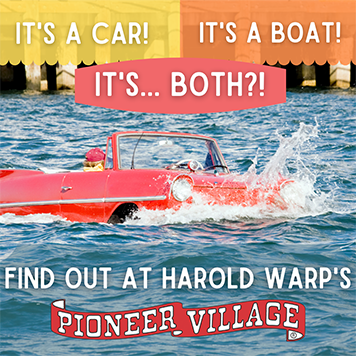The Amphibious car, also known as the Amphicar, that is displayed at Harold Warp Pioneer Village is one out of only 300-600 cars remaining in the United States. Designed by Hans Trippel, its production began in 1961 in Germany. Military variations of the Amphicar had already existed, but this was the first of its kind for solely made for everyday use. It developed the name Amphicar 770 because it could go about 70 miles per hour on land and 7 miles per hour on water. It was built with a 4-cylinder Triumph motor in the rear, along with two nylon propellers in the back. It had doors that were double sealed to prevent leakage, and it used its wheels as rudders to steer, and oars were provided. A sea-worthy car, it notably traveled across the English Channel in 1962, from San Diego to Catalina Island, and from Africa to Spain. It sold for a price of $2,800, or about $20,000 in today’s dollars.
“The Car Nebraskans Need Right Now”
This phrase was printed in a newspaper in 1962, citing the numerous damaged bridges from historic flooding in the area at the time. Many different marketing tactics were used to try to gain attraction. The Amphicar was marketed as a sports car that was perfect for a sportsman and his entire family, with one ad showing a picture of a man fishing from his car, and also marketed as a great vehicle for emergency responders.
Beloved By President Lyndon B. Johnson
President Johnson, 36th President of the United States who held office from 1961 – 1969, was one of the most famous people to own an Amphicar. A favorite party trick of his was to take his guests for a ride in the car and suddenly head straight for the lake located on his Texas ranch, while yelling that his brakes were out. The guests would at first be terrified, and then relieved when they realized the car was still afloat. Other notable owners of the Amphicar include John Lennon and Madonna.
A Fleeting Moment in the Spotlight
The Amphicar was made from 1961-1965, and the last car was sold in 1968. The cars certainly caused buzz for a while. Overall, about 3,000 cars were imported into the U.S., with the nation being the largest market for the cars by far, importing 90 percent of the cars produced. Clubs like the International Amphicar Owners Club (which still exists today!) and the Amphicar Club of America developed as well. Nevertheless, the car failed to take off for multiple reasons. Practicality is a large factor. Most people don’t need both a car and a boat as one and finding bodies of water with structure that allowed the car to efficiently enter and exit the water was difficult. The Amphicar had very average performance as a car and as a boat, and it required extensive and regular maintenance. It also faced pressure competing with increasingly popular luxury and sports cars. Lastly, the Amphicar’s design was not able to meet the new standard vehicle emissions requirements that took effect in the United States in 1968, essentially finalizing the car’s downfall.
Although the Amphicar is now a collectible novelty, perhaps someday a new variation of the car will return.


Recent Comments